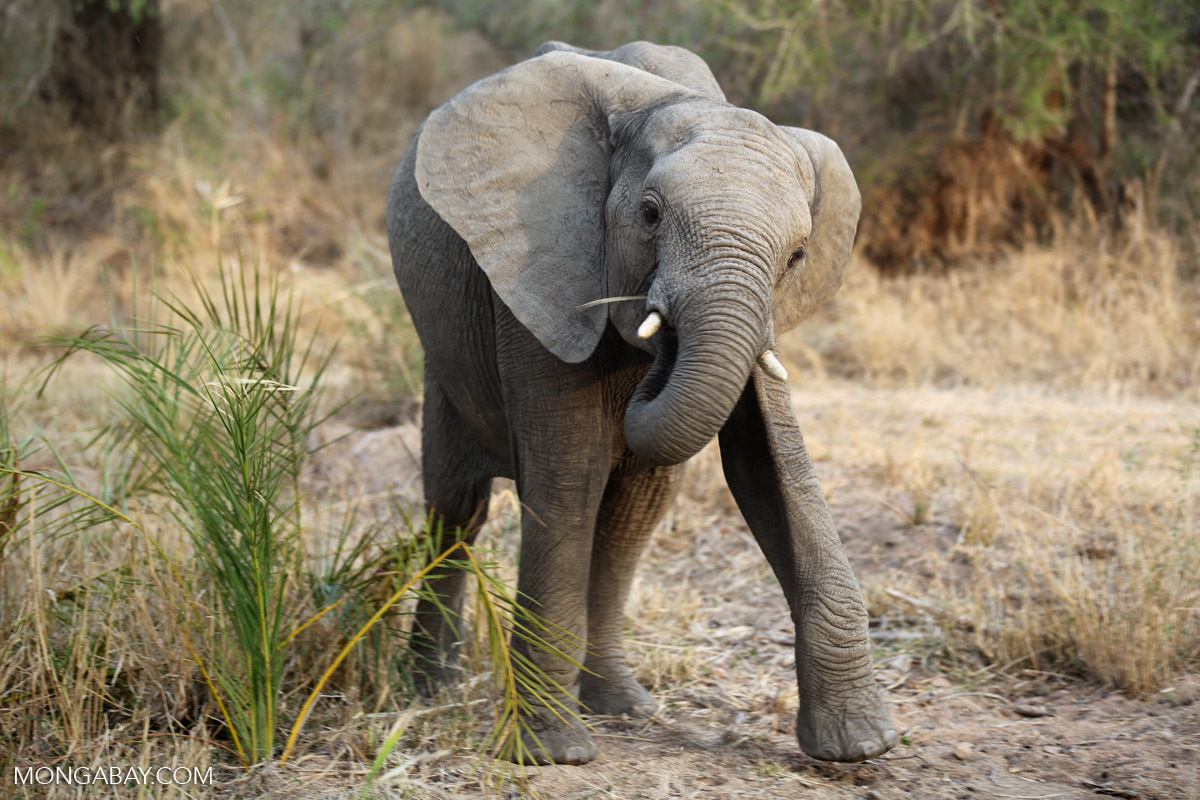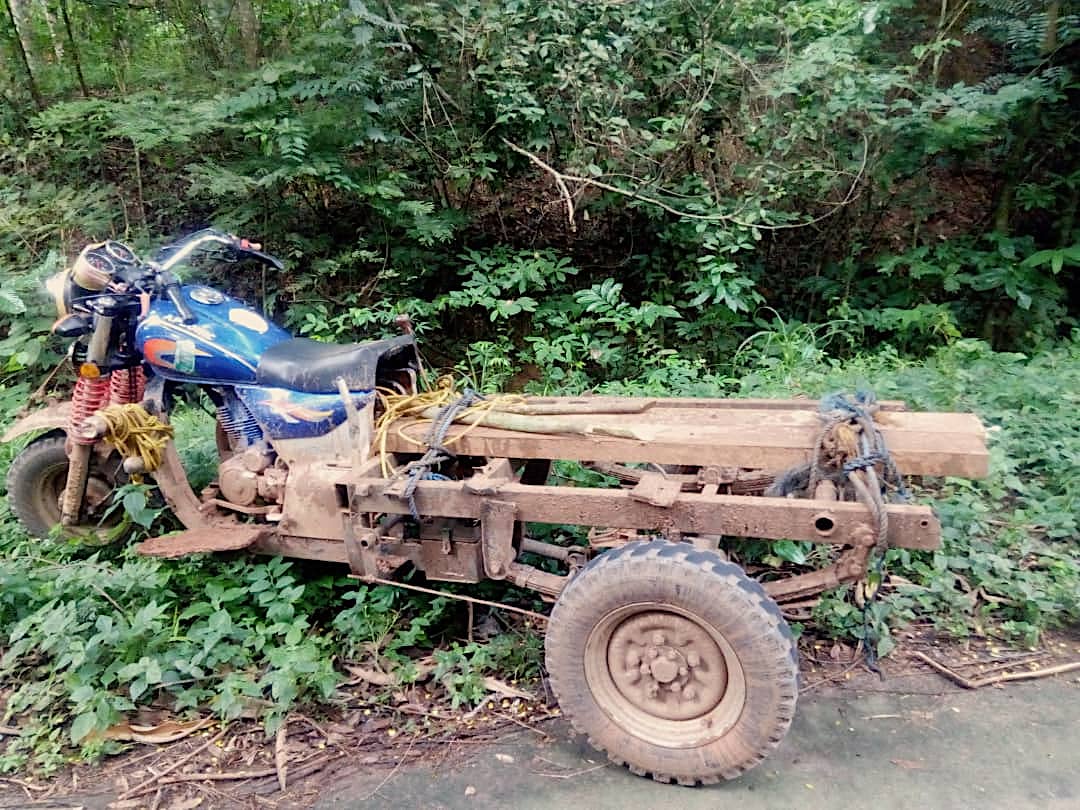- Deforestation of Ghana’s primary forests jumped 60 percent between 2017 and 2018 – the biggest jump of any tropical country. Most of this occurred in the country’s protected areas, including its forest reserves.
- A Mongabay investigation revealed that illegal logging in forest reserves is commonplace, with sources claiming officers from Ghana’s Forestry Commission often turn a blind eye and even participate in the activity.
- The technical director of forestry at Ghana’s Ministry of Lands and Natural Resources said attempts at intervention have met with limited success, and are often thwarted by loggers who know how to game the system.
- A representative of a conservation NGO operating in the country says a community-based monitoring project has helped curtail illegal logging in some reserves, but additional buy-in from other communities is needed to scale up its results. Meanwhile, the Ghanaian government is reportedly starting its own public outreach program, as well as coordinating with the EU on an agreement that would allow only legal wood from Ghana to enter the EU market.
KUMASI, Ghana — The West African country of Ghana is known for having rich natural resources including vast tracts of rainforest. But its primary forest has all but vanished, with what remains generally relegated to reserves scattered throughout the country’s southern third.
These reserves are under official protection. However, that hasn’t stopped logging and other illegal activities from deforesting them.
An analysis of satellite data published earlier this year by U.S.-based World Resource Institute (WRI), found Ghana experienced the biggest relative increase in primary forest loss of all tropical countries last year. According to the report, the loss of Ghana’s primary forest cover jumped 60 percent from 2017 to 2018 – almost entirely from its protected areas.

WRI found that while mining and logging were partly to blame for Ghana’s deforestation, the expansion of cocoa farms was the main culprit.
In response to WRI’s report, the Ghanaian government issued a statement through its Forestry Commission denying the findings. In its statement, the Forestry Commission said the WRI report was based on a faulty methodology as well as a misunderstanding of current controlled agricultural practices in Ghana. It refuted the 60 percent figure, saying instead that Ghana’s primary forest loss had increased by 31 percent between 2017 and 2018.
A publication by data analytics company Satelligence, however, affirmed WRI’s findings that Ghana deforestation did indeed experience a 60 percent jump. However, Satelligence’s report differs in one significant aspect from WRI’s: it says cocoa is not the main driver of deforestation in Ghana, instead laying blame on logging, mining, fire, and industrial agricultural expansion for other kinds of crops.
Forest reserves under attack
Ghana’s last remaining tracts of primary forest can only be found within areas granted official protection. However, even these are no longer immune to the advance of deforestation, with many hit hard by a surge of forest loss that began in April.
Stretching more than 20 kilometers (12 miles) along a bank of hills in the Ashanti region of southern Ghana, Tano-Offin Forest Reserve has lost more than 16 percent of its old-growth forest since 2001, according to satellite data from the University of Maryland. Several areas of the reserve are completely devoid of large trees, while the roar of chainsaws is ever-present, operated with impunity.

Sources on the ground say that illegal logging done at the hands of Ghanaian nationals as well as foreigners, especially Chinese nationals, appears to be the main cause of deforestation in the reserve.
“If you have come to look for trees in this forest then forget it because we have cut them all,” said a chainsaw operator who was illegally felling trees in the reserve to sell to a local buyer. The buyer showed up with a truck to haul off the logs.
Anane Frempong, the political head, or “assemblyman,” in Ghanaian parlance, of the Kyekyewere electoral area that comprises Tano-Offin, told Mongabay that his outfit seized some 6,000 pieces of timber last year that were harvested illegally in the reserve. These were handed over to officials from the Forestry Commission, which has established a task force to prevent illegal logging.

However, efforts to protect forests are often stymied. The chainsaw operator told Mongabay that loggers routinely bribed members of the task force to look the other way. This has seemingly created a situation of impunity, with trucks carrying timber in broad daylight from the reserve to the city of Kumasi a common sight, even though the Forestry Commission has set up checkpoints along the route. See Pictures
Fire, farms and mines
Illegal timber harvesting isn’t the only activity driving deforestation in Tano-Offin. Bush fires, set to clear land and aided by the dry harmattan season from November to March, have consumed large swaths of forest.
Human settlement in Tano-Offin has also contributed to the destruction of its forest. Half a dozen communities are situated deep inside the reserve, of which Kyekyewere is the largest. With a population of more than 1,000, Kyekyewere has some trappings of a modern town, including a school that provides education from the kindergarten level to junior high. However, there is no medical facility or electricity, and most community members depend on farming to survive.

Frempong, the Kyekyewere assemblyman, told Mongabay that the community had existed in the forest for more than 200 years, and that its residents had no other place to go. He said forest guards intimidated and harassed them whenever they farmed in the forest, alleging that last year they forced a resident of the community to swallow a dry plantain leaf, which Frempong says led to the man’s death a few days later.
“To mitigate this conflict, I will humbly appeal to the government of Ghana through the Forestry Commission to demarcate an area for farmland in the reserve to enable members of the community to have food to eat, as we have nowhere to call our town apart from the Kyekyewere community,” Frempong said.
Part of Tano-Offin is also rich in bauxite, which has prompted the Ghana Integrated Aluminium Corporation to begin establishing mining operations in the reserve. While mining has not yet started, infrastructure development is underway, with roads to prospective mining sites currently under construction.
Residents have expressed concern about the impacts mining might have on the forest, among them Nana Oppong Dinkyine. He told Mongabay that deforestation is already affecting water resources.
“The continuous depletion of the forest is seriously having a negative effect on our livelihood as our water bodies are being dried up and with the amount of rainfall dropping every year in this community, we are likely to face acute water shortage in the near future,” Dinkyine said. “That is why we are going to resist the mining operation in the forest — to protect our rivers.”
Bia Tano Forest Reserve is located about 30 kilometers (19 miles) northwest of Tano-Offin. Here, illegal logging is also underway. But sources say that Forestry Commission officials aren’t just allowing logging here — they’re actively participating in it.

Mongabay observed loggers transporting timber from Bia Tano through a checkpoint immediately west of the reserve. When confronted by the forest guard manning the checkpoint, one of the loggers said a forestry officer from Goaso district had allowed them to cut down trees in the reserve.
Upon hearing that the loggers had official permission, the guard allowed them to proceed.
“This is the challenge confronting us here,” said the guard, who asked not to be named. “Public officials are deeply involved in the illegal activities.”
Mongabay reached out to Ghana’s Forestry Commission, but requests for comment were not answered by the time this story was published.
Another forest guard who also spoke to Mongabay on condition of anonymity said that state officials were also giving out concessions in the reserve to their cronies.


At the Bediakokrom community just east of Bia Tano, dozens of sawmills can be seen just outside the reserve. The second forest guard told Mongabay that most of the owners of the sawmills had no permit to work in the reserve, but continued to log its forests.
Community leader Agya Bomba blamed the now-defunct Ayum Timber Company for the increase in illegal logging in Bia Tano. He said that a concession once leased by the company had since been invaded by illegal loggers, including former company staff.
Fighting back
Illegal logging in Ghana’s forest reserves was confirmed by Musah Abu-Juam, technical director in charge of forestry at Ghana’s Ministry of Lands and Natural Resources, who said the practice was ongoing both inside and outside protected areas.
“Because of the low number of the officials of the Forestry Commission, we still have high incidence of chainsawing both outside and inside the forest reserves,” he said.
Abu-Juam said the government was doing its best to fight back against illegal deforestation. He referred to one incident in which the Forestry Commission stopped buses loaded with illegal timber from a forest reserve and arrested the perpetrators.
However, Abu-Juam said that although the government of Ghana was making an effort to improve the monitoring mechanisms in the reserves, those involved in the illegal activity often find ways to outwit these measures. He cited a case in which illegal operators tried fooling forest guards by entering a reserve during the night, cutting down trees, and making them into semi-finished doors in the forest before transporting them out before daybreak.

He also mentioned a recent arrest made when Forestry Commission officials discovered loggers were transporting illegal wood from a reserve by hiding it in coffins.
Abu-Juam said the government had introduced a program rewarding people who report illegal logging. However, he said the program suffered a setback as illegal operators impersonated whistle-blowers to send forestry officials on a wild goose chase in one area while they logged in another.
He also blamed deforestation on forest-dependent communities, saying “their continuous expansion is destructive to the reserves in which they live.”
However, some say these communities could also be a key to saving Ghana’s forest reserves. Friends of the Earth (FoE) Ghana, an NGO, has initiated a program called “community-based real-time monitoring” to try and clamp down on the country’s rampant illegal logging.
Dennis Acquah, project coordinator for FoE-Ghana, said the program has helped build capacity in communities living within forests to detect and report illegal activities as they’re happening by using a mobile phone app.
“With the project, FoE-Ghana selected some members of the forest fringe communities, trained them to be conversant with forest laws and mobile systems applications … to collect and transmit quality data, which can be in a form of video, audio or picture, and transmit the data onto [a] centralized database,” Acquah said. “FoE then collaborate[s] with the Forestry Commission for verification of the alerts and then take action.”
Acquah said the project had yielded positive results, including driving many illegal loggers from reserves and the confiscation of illegal timber. He said this success could be scaled up and urged the involvement of all forest communities.

According to Abu-Juam, the Ministry of Lands and Natural Resources is also engaging members of the public, particularly those living around the reserves, to fight illegal logging. He added that a special court had been established, with trained local forestry officials acting as prosecutors to deal with cases involving illegal operators in the reserves.
Ghana is also tapping into international support to combat illegal logging. Abu-Juam said the governments of Ghana and the European Union had entered into an agreement that would allow only legal wood to enter the EU market, and had established the Legality Assurance System, which tracks each piece of timber from where it is cut to where it is sold.
“The government of Ghana has reached very far with the EU to make the agreement work and it will soon issue the forest law enforcement, governance and trade license for the agreement to take [effect],” Abu-Juam told Mongabay.
Banner image: Young common chimpanzees ponder their future. Image by Delphine Bruyere via Wikimedia Commons (CC BY-SA 3.0)
Editor’s note: This story was powered by Places to Watch, a Global Forest Watch (GFW) initiative designed to quickly identify concerning forest loss around the world and catalyze further investigation of these areas. Places to Watch draws on a combination of near-real-time satellite data, automated algorithms and field intelligence to identify new areas on a monthly basis. In partnership with Mongabay, GFW is supporting data-driven journalism by providing data and maps generated by Places to Watch. Mongabay maintains complete editorial independence over the stories reported using this data.
Feedback: Use this form to send a message to the editor of this post. If you want to post a public comment, you can do that at the bottom of the page.
Subscribe To Our Newsletter
You have Successfully Subscribed!












